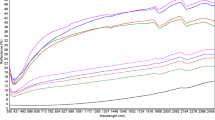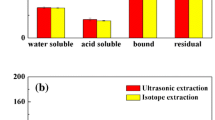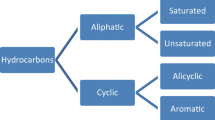Abstract
Background
Prediction of polycyclic aromatic hydrocarbons (PAHs) desorption from soil to estimate available fraction regarding to initial concentration of the contaminant is of great important in soil pollution management, which has poorly been understood until now. In the present study estimation of fast desorption fraction which is considered as available fraction was conducted by evaluating desorption kinetics of phenanthrene (a three ring PAH) from artificially contaminated soils through the mathematical models.
Methods
Desorption rate of phenanthrene (PHE) was investigated by using the nonionic surfactant Tween80 in a series of batch experiments. The effects of reaction time from 5 to 1440 min and initial PHE concentration in the range of 100–1600 mg/kg were studied.
Results
Available fractions of the contaminant were achieved within the first hour of desorption process as the system reached to equilibrium conditions. Experimental data were examined by using kinetic models including pseudo-first-order, pseudo-second-order in four linearized forms, and fractional power. Among the models tested, experimental data were well described by pseudo-second-order model type (III) and (IV) and fractional power equation. Fast desorption rates, as Available fractions were determined 79%, 46%, 40%, 39%, and 35% for initial PHE concentrations of 100, 400, 800, 1200, and 1600 mg/kg respectively. Among the evaluated isotherm models, including Freundlich, Langmuir in four linearized forms, and Temkin, the equilibrium data were well fitted by the first one.
Conclusion
Applying the nonionic surfactant Tween80 is a useful method to determine available fraction of the contaminant. This method will provide the management of contaminated sites by choosing a proper technique for remediation and predicting achievable treatment efficiency.







Similar content being viewed by others
References
López-Vizcaíno R, Sáez C, Cañizares P, Rodrigo MA. The use of a combined process of surfactant-aided soil washing and coagulation for PAH-contaminated soils treatment. Sep Purif Technol. 2012;88:46–51. https://doi.org/10.1016/j.seppur.2011.11.038.
Ravanipour M, Kalantary R, Mohseni-Bandpi A, Esrafili A, Farzadkia M, Hashemi-Najafabadi S. Experimental design approach to the optimization of PAHs bioremediation from artificially contaminated soil: application of variables screening development. J Environ Health Sci Eng. 2015;13(1):1–10. https://doi.org/10.1186/s40201-015-0178-y.
Aryal M, Liakopoulou-Kyriakides M. Biodegradation and kinetics of phenanthrene and pyrene in the presence of nonionic surfactants by Arthrobacter strain Sphe3. Water Air Soil Pollut. 2013;224(2):1–10. https://doi.org/10.1007/s11270-012-1426-8.
Rezaei Kalantari R, Badkoubi A, Mohseni-bandpi A, Esrafili A, Jorfi S, Dehghanifard E. Modification of PAHs biodegradation with humic compounds. Soil Sediment Contam. 2013;22(2):185–98.
Portet-Koltalo F, Ammami MT, Benamar A, Wang H, Le Derf F, Duclairoir-Poc C. Investigation of the release of PAHs from artificially contaminated sediments using cyclolipopeptidic biosurfactants. J Hazard Mater. 2013;261:593–601. https://doi.org/10.1016/j.jhazmat.2013.07.062.
Mao J, Luo Y, Teng Y, Li Z. Bioremediation of polycyclic aromatic hydrocarbon-contaminated soil by a bacterial consortium and associated microbial community changes. Int Biodeterior Biodegrad 2012;70(0):141–147. https://doi.org/10.1016/j.ibiod.2012.03.002.
Kalantary RR, Mohseni-Bandpi A, Esrafili A, Nasseri S, Ashmagh FR, Jorfi S, et al. Effectiveness of biostimulation through nutrient content on the bioremediation of phenanthrene contaminated soil. J Environ Health Sci Eng. 2014;12(1):143. https://doi.org/10.1186/s40201-014-0143-1.
Yap CL, Gan S, Ng HK. Ethyl lactate-Fenton treatment of soil highly contaminated with polycyclic aromatic hydrocarbons (PAHs). Chem Eng J. 2012;200–202:247–56. https://doi.org/10.1016/j.cej.2012.06.036.
Saberi N, Aghababaei M, Ostovar M, Mehrnahad H. Simultaneous removal of polycyclic aromatic hydrocarbon and heavy metals from an artificial clayey soil by enhanced electrokinetic method. J Environ Manag. 2018;217:897–905. https://doi.org/10.1016/j.jenvman.2018.03.125.
Falciglia PP, Malarbì D, Greco V, Vagliasindi FGA. Surfactant and MGDA enhanced – Electrokinetic treatment for the simultaneous removal of mercury and PAHs from marine sediments. Sep Purif Technol. 2017;175:330–9. https://doi.org/10.1016/j.seppur.2016.11.046.
Zhou W, Zhu L. Enhanced soil flushing of phenanthrene by anionic–nonionic mixed surfactant. Water Res. 2008;42(1–2):101–8. https://doi.org/10.1016/j.watres.2007.07.021.
Mousset E, Huguenot D, van Hullebusch ED, Oturan N, Guibaud G, Esposito G, et al. Impact of electrochemical treatment of soil washing solution on PAH degradation efficiency and soil respirometry. Environ Pollut. 2016;211:354–62. https://doi.org/10.1016/j.envpol.2016.01.021.
Fonseca B, Pazos M, Figueiredo H, Tavares T, Sanromán MA. Desorption kinetics of phenanthrene and lead from historically contaminated soil. Chem Eng J. 2011;167(1):84–90. https://doi.org/10.1016/j.cej.2010.12.004.
Barnier C, Ouvrard S, Robin C, Morel JL. Desorption kinetics of PAHs from aged industrial soils for availability assessment. Sci Total Environ. 2014;470-471:639–45. https://doi.org/10.1016/j.scitotenv.2013.10.032.
Mouton J, Mercier G, Blais J-F. Amphoteric surfactants for PAH and lead polluted-soil treatment using flotation. Water Air Soil Pollut. 2009;197(1–4):381–93. https://doi.org/10.1007/s11270-008-9819-4.
Ahn CK, Kim YM, Woo SH, Park JM. Soil washing using various nonionic surfactants and their recovery by selective adsorption with activated carbon. J Hazard Mater 2008;154(1–3):153–60. https://doi.org/10.1016/j.jhazmat.2007.10.006, 153.
Wei Y, Liang X, Lin W, Guo C, Dang Z. Clay mineral dependent desorption of pyrene from soils by single and mixed anionic–nonionic surfactants. Chem Eng J. 2015;264:807–14. https://doi.org/10.1016/j.cej.2014.12.019.
Zhu L, Zhou W. Partitioning of polycyclic aromatic hydrocarbons to solid-sorbed nonionic surfactants. Environ Pollut. 2008;152(1):130–7. https://doi.org/10.1016/j.envpol.2007.05.001.
Alcántara MT, Gómez J, Pazos M, Sanromán MA. PAHs soil decontamination in two steps: desorption and electrochemical treatment. J Hazard Mater. 2009;166(1):462–8. https://doi.org/10.1016/j.jhazmat.2008.11.050.
Jin D, Jiang X, Jing X, Ou Z. Effects of concentration, head group, and structure of surfactants on the degradation of phenanthrene. J Hazard Mater. 2007;144(1–2):215–21. https://doi.org/10.1016/j.jhazmat.2006.10.012.
Haddadi SH, Niri VH, Pawliszyn J. Study of desorption kinetics of polycyclic aromatic hydrocarbons (PAHs) from solid matrices using internally cooled coated fiber. Anal Chim Acta. 2009;652(1–2):224–30. https://doi.org/10.1016/j.aca.2009.05.026.
Cheng KY, Wong JWC. Combined effect of nonionic surfactant tween 80 and DOM on the behaviors of PAHs in soil–water system. Chemosphere. 2006;62(11):1907–16. https://doi.org/10.1016/j.chemosphere.2005.07.028.
Peng S, Wu W, Chen J. Removal of PAHs with surfactant-enhanced soil washing: influencing factors and removal effectiveness. Chemosphere. 2011;82(8):1173–7. https://doi.org/10.1016/j.chemosphere.2010.11.076.
Zhou W, Zhu L. Efficiency of surfactant-enhanced desorption for contaminated soils depending on the component characteristics of soil-surfactant–PAHs system. Environ Pollut. 2007;147(1):66–73. https://doi.org/10.1016/j.envpol.2006.08.018.
Gharibzadeh F, Rezaei Kalantary R, Nasseri S, Esrafili A, Azari A. Reuse of polycyclic aromatic hydrocarbons (PAHs) contaminated soil washing effluent by bioaugmentation/biostimulation process. Sep Purif Technol. 2016;168:248–56. https://doi.org/10.1016/j.seppur.2016.05.022.
Laha S, Tansel B, Ussawarujikulchai A. Surfactant–soil interactions during surfactant-amended remediation of contaminated soils by hydrophobic organic compounds: a review. J Environ Manag. 2009;90(1):95–100. https://doi.org/10.1016/j.jenvman.2008.08.006.
Saeedi M, Li LY, Grace JR. Desorption and mobility mechanisms of co-existing polycyclic aromatic hydrocarbons and heavy metals in clays and clay minerals. J Environ Manag. 2018;214:204–14. https://doi.org/10.1016/j.jenvman.2018.02.065.
Zhao B, Zhu L, Gao Y. A novel solubilization of phenanthrene using Winsor I microemulsion-based sodium castor oil sulfate. J Hazard Mater. 2005;119(1):205–11. https://doi.org/10.1016/j.jhazmat.2004.12.009.
Viglianti C, Hanna K, de Brauer C, Germain P. Removal of polycyclic aromatic hydrocarbons from aged-contaminated soil using cyclodextrins: experimental study. Environ Pollut. 2006;140(3):427–35. https://doi.org/10.1016/j.envpol.2005.08.002.
Wang G, Zhou Y, Wang X, Chai X, Huang L, Deng N. Simultaneous removal of phenanthrene and lead from artificially contaminated soils with glycine-β-cyclodextrin. J Hazard Mater. 2010;184(1–3):690–5. https://doi.org/10.1016/j.jhazmat.2010.08.094.
Behnamfard A, Salarirad MM. Equilibrium and kinetic studies on free cyanide adsorption from aqueous solution by activated carbon. J Hazard Mater. 2009;170(1):127–33. https://doi.org/10.1016/j.jhazmat.2009.04.124.
Ahmadi M, Hazrati Niari M, Kakavandi B. Development of maghemite nanoparticles supported on cross-linked chitosan (γ-Fe2O3@CS) as a recoverable mesoporous magnetic composite for effective heavy metals removal. J Mol Liq. 2017;248:184–96. https://doi.org/10.1016/j.molliq.2017.10.014.
Zhou W, Wang X, Chen C, Zhu L. Enhanced soil washing of phenanthrene by a plant-derived natural biosurfactant, Sapindus saponin. Colloids Surf A Physicochem Eng Asp. 2013;425(0):122–8. https://doi.org/10.1016/j.colsurfa.2013.02.055.
Yu H, Huang G-h, An C-j, Wei J. Combined effects of DOM extracted from site soil/compost and biosurfactant on the sorption and desorption of PAHs in a soil–water system. J Hazard Mater. 2011;190(1–3):883–90. https://doi.org/10.1016/j.jhazmat.2011.04.026.
Acknowledgements
This research has been supported by Tehran University of Medical Sciences & health Services [grant number 93-02-61-25084].
Author information
Authors and Affiliations
Corresponding author
Ethics declarations
Conflict of interest
The authors declare that they have no conflict of interest.
Additional information
Publisher’s note
Springer Nature remains neutral with regard to jurisdictional claims in published maps and institutional affiliations.
Rights and permissions
About this article
Cite this article
Gharibzadeh, F., Kalantary, R.R., Esrafili, A. et al. Desorption kinetics and isotherms of phenanthrene from contaminated soil. J Environ Health Sci Engineer 17, 171–181 (2019). https://doi.org/10.1007/s40201-019-00338-1
Received:
Accepted:
Published:
Issue Date:
DOI: https://doi.org/10.1007/s40201-019-00338-1




